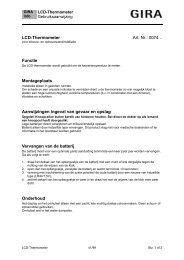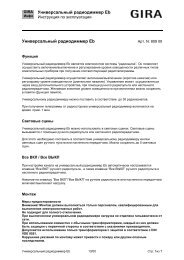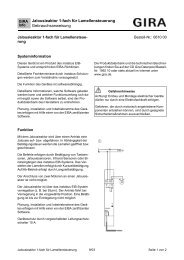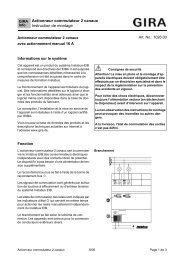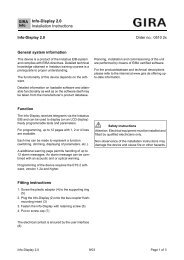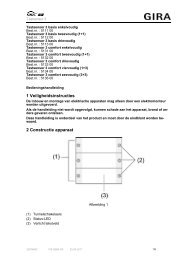Blind actuator 1-gang flush-mounted Order-No. 2165 00 - Gira
Blind actuator 1-gang flush-mounted Order-No. 2165 00 - Gira
Blind actuator 1-gang flush-mounted Order-No. 2165 00 - Gira
You also want an ePaper? Increase the reach of your titles
YUMPU automatically turns print PDFs into web optimized ePapers that Google loves.
Software "Venetian blind, input 20BD11"<br />
Functional description<br />
parameter on the parameter page "Ix - General " (x = 1, 2, 3) can be used to define which object<br />
value is transmitted to the bus when there is a rising or falling flank at the input (no reaction,<br />
ON, OFF, TOGGLE - switchover of the object value). <strong>No</strong> distinction is made between a brief or<br />
long signal flank/actuation in the "Switching" function.<br />
Response to bus voltage return<br />
After a device reset (bus voltage return or ETS programming operation), the communication<br />
objects of the input can be initialised. For this, the "Behaviour on bus voltage return" parameter<br />
should be configured to the required reaction. In the settings "On telegram" or "Off telegram"<br />
telegrams are transmitted actively to the bus according to this requirement. In the "Transmit<br />
current input status" setting, the device evaluates the static signal status of the input and,<br />
according to this, transmits the appropriately configured telegram to the bus (contact closed at<br />
the input = telegram as with rising flank; contact open at input = telegram as with falling flank).<br />
If, in this case, the flank command dependent on the current status is configured to "<strong>No</strong><br />
reaction", the device does not transmit a telegram to the bus on initialisation.<br />
If, in the ETS, a delay is set for the extension inputs after bus voltage return, the device only<br />
transmits the telegrams when the delay has elapsed.<br />
Cyclical transmission<br />
Optionally, the object values can be transmitted cyclically to the bus for the "Switching" function.<br />
For this, the transmission criteria must first be defined in the ETS. The "Transmit cyclically ?"<br />
parameter on the parameter page "Ix - Transmit cyclically" (x = 1, 2, 3) specifies with which<br />
value cyclical transmission should take place. Depending on requirements, it is possible to<br />
transmit cyclically via both or just one switching object(s). In addition, it is possible to define the<br />
cycle time separately for both switching objects in the ETS.<br />
The object value entered in the switching objects by the device on a flank change or externally<br />
by the bus is always transmitted cyclically. The object value is then also transmitted cyclically<br />
when "no reaction" is assigned to a rising or falling flank. Cyclical transmission also takes place<br />
directly after bus voltage return, if the reaction after bus voltage return corresponds to the<br />
transmission criterion for cyclical transmission. During an active disable, no cyclical<br />
transmissions take place via the disabled input.<br />
Dimming function<br />
For each input whose function is set to "Dimming", the ETS indicates a 1-bit "Switching" and a<br />
4-bit "Dimming" object. In general, the device transmits a switching telegram on a short time<br />
input signal (triggered by the rising flank of a closed contact) and a dimming telegram on a long<br />
signal. In the standard configuration, the device transmits a telegram for stopping the dimming<br />
action after a long signal.<br />
The length of time the input signal (closed pushbutton or switch) must last until a long actuation<br />
is detected can be set using the parameter "Time between switching and dimming" on the<br />
parameter page "Ix - General" (x = 1, 2, 3).<br />
Operating principle<br />
The "Operation" parameter specifies the operating principle. In the presetting of the dimming<br />
function, two-surface operation is specified here. This means that the input transmits a telegram<br />
for switching on after a short signal length and a telegram for increasing the brightness after a<br />
long signal length ("Brighter"). Alternatively, the device can transmit a telegram for switching off<br />
after a short signal length and a telegram for reducing the brightness after a long signal length<br />
("Darker").<br />
With a single-surface dimming function, the input transmits switch-on and switch-off telegrams<br />
("TOGGLE") in an alternating pattern for each short signal. After long signals, the device<br />
transmits "brighter" and "darker" telegrams in an alternating pattern.<br />
<strong>Order</strong>-<strong>No</strong>. <strong>2165</strong> <strong>00</strong><br />
Page 30 of 149



